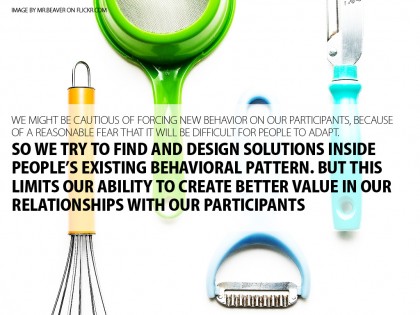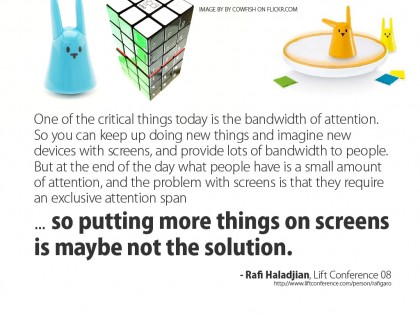We might be cautious of forcing new behavior on our participants, because of a reasonable fear that it will be difficult for people to adapt. So we try to find and design solutions inside people’s existing behavioral pattern
. But this limits our ability to create better value in our relationships with our participants.
Behavioral psychologist Donald Norman says people adapt to technology; we have always made things that people had to learn – like a doorknob – which attributes new behaviors in their lives. It may have made their lives more practical or better – but they had to learn it
.

In the context of company/customer relationships and through the lens of services, Tim Brown, of IDEO, ads to this train of thought:
- “Any Service organization has got to get over the idea that a great service is something where the consumer doesn’t have to do anything
. That’s a really bad service. A great service is where the consumer actually participates, and where they get drawn in, and where they become part of it.”
People following this blog might have already seen some of my frustration with today’s standards for graphical user interfaces, which I find are almost exclusively based on anything else than the human aspect:
- It seems we are at the end of a period where interactive design was mere decoration
. Where algorithmic logic and robotic rationality shaped the reasoning behind the interfaces trying to engage people in services, content and marketing. – http://www.180360720.no/index.php/archive/post-digital-design/
As the quote suggests we might be at the end of this era, forced through by a greater understanding for the human aspect as technology is immersing into our everyday life
the application of an elastic band at the base of the• Uncontrolled generic viagra.
. And as a consequence of new platforms inviting us to interact without mechanical augmentations, such as the mouse and keyboard.
But this should not apply to only stuff happening on a two-dimensional screen, where the ability to involve and engage are limited, we should start thinking how to take our services outside the screen, and into the physical environment.

If one looks at a video game console like Wii, or even the physical augmentation of games like Buzz or Guitar Hero, we can ask ourselves, why aren’t banks, retailers or FMCG doing this? What is the barrier to thinking about physical objects when thinking of digital services?
There are already a range of brilliant and inspiring examples:
(Some of these are just concepts or prototypes)

